2011 Hyundai H-1 (Grand Starex) transmission
[x] Cancel search: transmissionPage 274 of 346
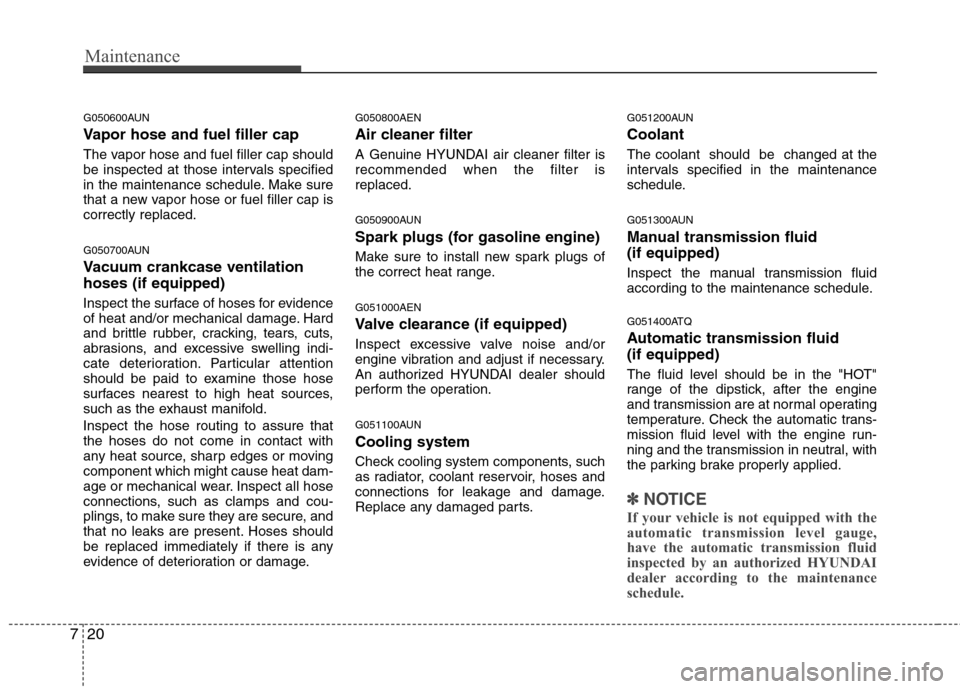
Maintenance
20
7
G050600AUN
Vapor hose and fuel filler cap
The vapor hose and fuel filler cap should
be inspected at those intervals specified
in the maintenance schedule. Make sure
that a new vapor hose or fuel filler cap iscorrectly replaced.
G050700AUN
Vacuum crankcase ventilation hoses (if equipped)
Inspect the surface of hoses for evidence
of heat and/or mechanical damage. Hard
and brittle rubber, cracking, tears, cuts,
abrasions, and excessive swelling indi-
cate deterioration. Particular attention
should be paid to examine those hose
surfaces nearest to high heat sources,
such as the exhaust manifold. Inspect the hose routing to assure that the hoses do not come in contact with
any heat source, sharp edges or movingcomponent which might cause heat dam-
age or mechanical wear. Inspect all hose
connections, such as clamps and cou-
plings, to make sure they are secure, and
that no leaks are present. Hoses should
be replaced immediately if there is any
evidence of deterioration or damage. G050800AEN
Air cleaner filter
A Genuine HYUNDAI air cleaner filter is recommended when the filter isreplaced.
G050900AUN
Spark plugs (for gasoline engine)
Make sure to install new spark plugs of
the correct heat range. G051000AEN
Valve clearance (if equipped)
Inspect excessive valve noise and/or
engine vibration and adjust if necessary.
An authorized HYUNDAI dealer should
perform the operation.
G051100AUN Cooling system
Check cooling system components, such
as radiator, coolant reservoir, hoses and
connections for leakage and damage.
Replace any damaged parts.
G051200AUN Coolant The coolant should be changed at the
intervals specified in the maintenance
schedule.
G051300AUN
Manual transmission fluid (if equipped)
Inspect the manual transmission fluid
according to the maintenance schedule.
G051400ATQ
Automatic transmission fluid (if equipped)
The fluid level should be in the "HOT"
range of the dipstick, after the engine
and transmission are at normal operating
temperature. Check the automatic trans-
mission fluid level with the engine run-
ning and the transmission in neutral, with
the parking brake properly applied.
✽✽
NOTICE
If your vehicle is not equipped with the
automatic transmission level gauge,
have the automatic transmission fluid
inspected by an authorized HYUNDAI
dealer according to the maintenance
schedule.
Page 281 of 346
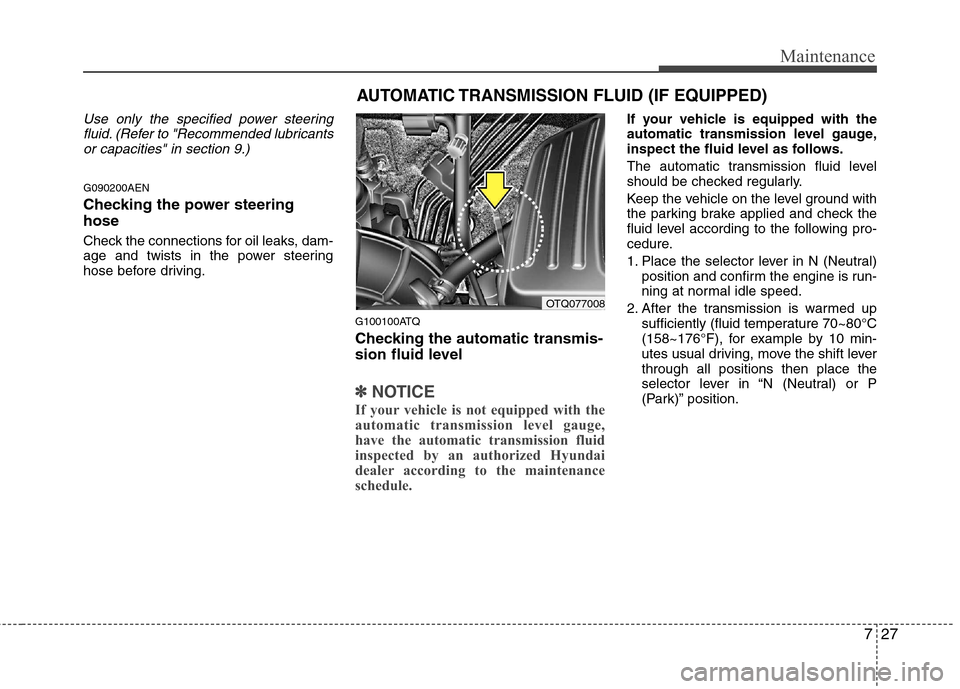
727
Maintenance
Use only the specified power steeringfluid. (Refer to "Recommended lubricantsor capacities" in section 9.)
G090200AEN
Checking the power steering hose
Check the connections for oil leaks, dam-
age and twists in the power steering
hose before driving.
G100100ATQ
Checking the automatic transmis-
sion fluid level
✽✽NOTICE
If your vehicle is not equipped with the
automatic transmission level gauge,
have the automatic transmission fluid
inspected by an authorized Hyundai
dealer according to the maintenance
schedule.
If your vehicle is equipped with the
automatic transmission level gauge,
inspect the fluid level as follows.
The automatic transmission fluid level
should be checked regularly.
Keep the vehicle on the level ground with
the parking brake applied and check the
fluid level according to the following pro-
cedure.
1. Place the selector lever in N (Neutral) position and confirm the engine is run-
ning at normal idle speed.
2. After the transmission is warmed up sufficiently (fluid temperature 70~80°C
(158~176°F), for example by 10 min-
utes usual driving, move the shift leverthrough all positions then place the
selector lever in “N (Neutral) or P
(Park)” position.
AUTOMATIC TRANSMISSION FLUID (IF EQUIPPED)
OTQ077008
Page 282 of 346
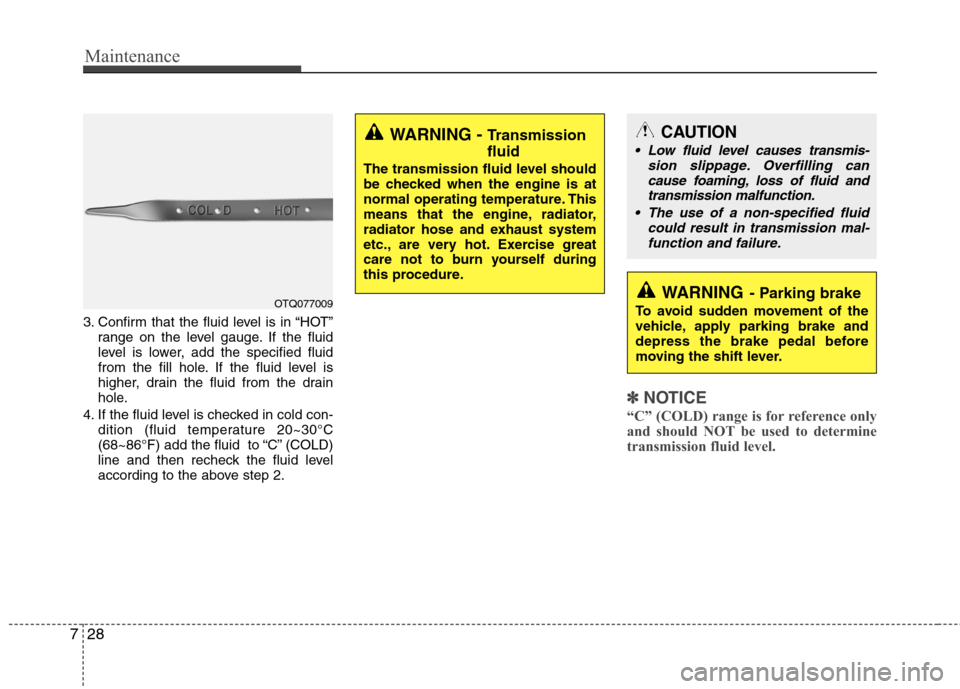
Maintenance
28
7
3. Confirm that the fluid level is in “HOT”
range on the level gauge. If the fluid
level is lower, add the specified fluid
from the fill hole. If the fluid level is
higher, drain the fluid from the drain
hole.
4. If the fluid level is checked in cold con- dition (fluid temperature 20~30°C
(68~86°F) add the fluid to “C” (COLD)
line and then recheck the fluid level
according to the above step 2.
✽✽ NOTICE
“C” (COLD) range is for reference only
and should NOT be used to determine
transmission fluid level.
OTQ077009
WARNING - Transmission fluid
The transmission fluid level should
be checked when the engine is at
normal operating temperature. This
means that the engine, radiator,
radiator hose and exhaust system
etc., are very hot. Exercise great
care not to burn yourself during
this procedure.
WARNING - Parking brake
To avoid sudden movement of the
vehicle, apply parking brake and
depress the brake pedal before
moving the shift lever.
CAUTION
Low fluid level causes transmis- sion slippage. Overfilling can
cause foaming, loss of fluid and transmission malfunction.
The use of a non-specified fluid could result in transmission mal-
function and failure.
Page 283 of 346
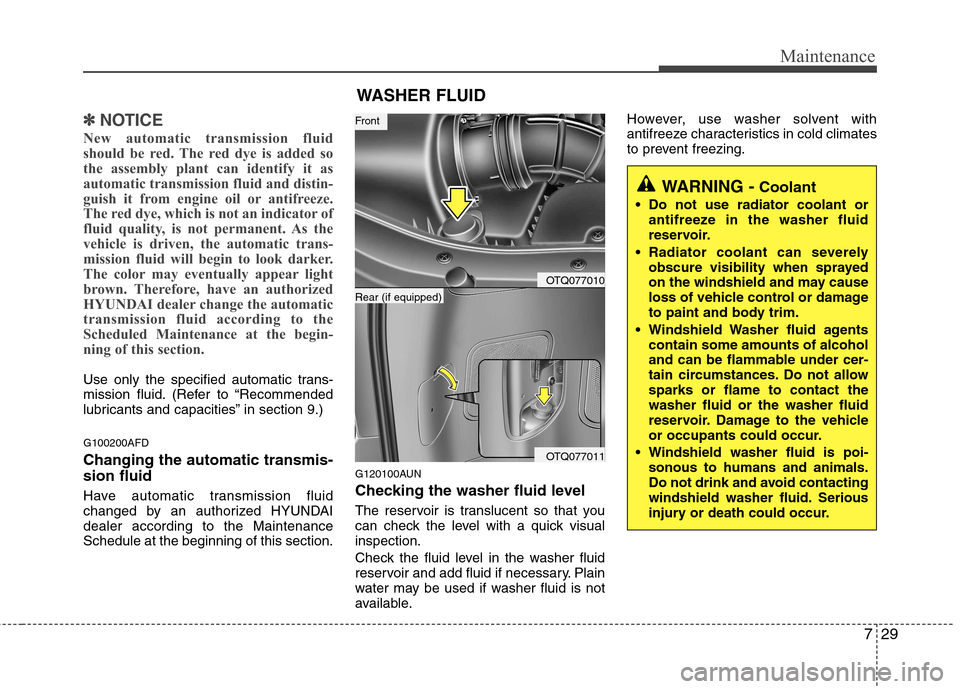
729
Maintenance
✽✽NOTICE
New automatic transmission fluid
should be red. The red dye is added so
the assembly plant can identify it as
automatic transmission fluid and distin-
guish it from engine oil or antifreeze.
The red dye, which is not an indicator of
fluid quality, is not permanent. As the
vehicle is driven, the automatic trans-
mission fluid will begin to look darker.
The color may eventually appear light
brown. Therefore, have an authorized
HYUNDAI dealer change the automatic
transmission fluid according to the
Scheduled Maintenance at the begin-
ning of this section.
Use only the specified automatic trans-
mission fluid. (Refer to “Recommended
lubricants and capacities” in section 9.) G100200AFD Changing the automatic transmis- sion fluid
Have automatic transmission fluid
changed by an authorized HYUNDAIdealer according to the MaintenanceSchedule at the beginning of this section. G120100AUN
Checking the washer fluid level
The reservoir is translucent so that you
can check the level with a quick visualinspection.
Check the fluid level in the washer fluid
reservoir and add fluid if necessary. Plain
water may be used if washer fluid is not
available.However, use washer solvent with
antifreeze characteristics in cold climates
to prevent freezing.
WARNING -
Coolant
Do not use radiator coolant or antifreeze in the washer fluid
reservoir.
Radiator coolant can severely obscure visibility when sprayed
on the windshield and may cause
loss of vehicle control or damage
to paint and body trim.
Windshield Washer fluid agents contain some amounts of alcohol
and can be flammable under cer-
tain circumstances. Do not allowsparks or flame to contact thewasher fluid or the washer fluid
reservoir. Damage to the vehicle
or occupants could occur.
Windshield washer fluid is poi- sonous to humans and animals.
Do not drink and avoid contacting
windshield washer fluid. Serious
injury or death could occur.
OTQ077010
OTQ077011
Rear (if equipped)
Front
WASHER FLUID
Page 307 of 346
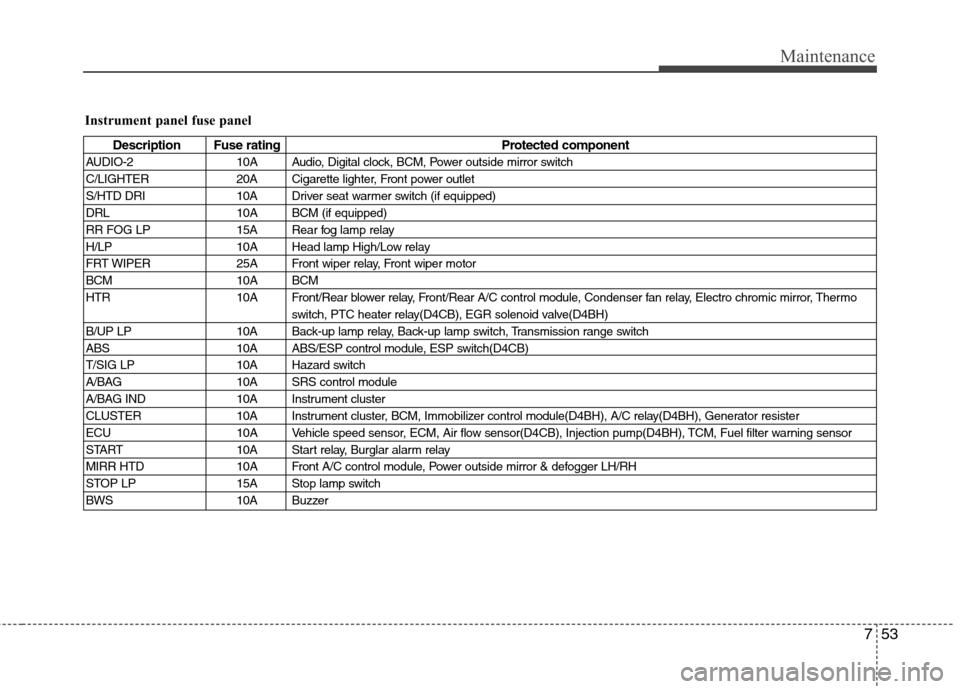
753
Maintenance
Instrument panel fuse panel
Description Fuse ratingProtected component
AUDIO-2 10A Audio, Digital clock, BCM, Power outside mirror switch
C/LIGHTER 20A Cigarette lighter, Front power outlet
S/HTD DRI 10A Driver seat warmer switch (if equipped)
DRL 10A BCM (if equipped)
RR FOG LP 15A Rear fog lamp relay
H/LP 10A Head lamp High/Low relay
FRT WIPER 25A Front wiper relay, Front wiper motor
BCM 10A BCM
HTR 10A Front/Rear blower relay, Front/Rear A/C control module, Condenser fan relay, Electro chromic mirror, Thermo switch, PTC heater relay(D4CB), EGR solenoid valve(D4BH)
B/UP LP 10A Back-up lamp relay, Back-up lamp switch, Transmission range switch
ABS 10A ABS/ESP control module, ESP switch(D4CB)
T/SIG LP 10A Hazard switch
A/BAG 10A SRS control module
A/BAG IND 10A Instrument cluster
CLUSTER 10A Instrument cluster, BCM, Immobilizer control module(D4BH), A/C relay(D4BH), Generator resister
ECU 10A Vehicle speed sensor, ECM, Air flow sensor(D4CB), Injection pump(D4BH), TCM, Fuel filter warning sensor
START 10A Start relay, Burglar alarm relay
MIRR HTD 10A Front A/C control module, Power outside mirror & defogger LH/RH
STOP LP 15A Stop lamp switch
BWS 10A Buzzer
Page 334 of 346

Specifications
4
9
RECOMMENDED LUBRICANTS AND CAPACITIES
I040000GTQ
To help achieve proper engine and powertrain performance and durability, use only lubricants of the proper quality. The correct
lubricants also help promote engine efficiency that results in improved fuel economy.
These lubricants and fluids are recommended for use in your vehicle.
* 1
Refer to the recommended SAE viscosity numbers on page 9-6.
* 2
Engine oils labeled Energy Conserving Oil are now available. Along with other additional benefits, they contribute to fuel econo my by reducing
the amount of fuel necessary to overcome engine friction. Often, these improvements are difficult to measure in everyday driving, but in a year’s
time, they can offer significant cost and energy savings.
* 3
VGT : Variable Geometry Turbocharger
* 4
WGT : Waste Gate Turbocharger
* 5
If the API service SM engine oil is not available in your country, you are able to use API service SL. Lubricant
Volume (
l/ US qt.)
Classification
Engine oil * 1
*2
(drain and refill) Recommends Diesel engineA2.5 7.4 (7.82)
VGT*
3
: API Service CH-4 or above, ACEA B4
WGT* 4
: API Service CF-4 or above, ACEA B4
4D56 5.4 (5.71) PI Service CF-4 or above, ACEA B2 or B3
Gasoline engine 5.1 (5.39) API Service SM* 5
, ILSAC GF-4 or above
Engine oil consumption Normal driving condition
MAX. 1
l/1500 km
-
Severe driving condition MAX. 1
l/1000 km
-
Manual transmissionfluid A2.5 Diesel engine 3.0 (3.17)
API Service GL-4
SAE 75W/85
4D56 Diesel engine &
Gasoline engine 1.95 (2.06)
Automatic transmis-sion fluid A2.5 Diesel engine 10.0 (10.60) APOLLOIL ATF RED-1
4D56 Diesel engine & Gasoline engine 8.0 (8.45)CASTLE AUTO FLUID T-IV, DIAMOND ATF SP-I or
other brans approved by Hyundai Motor Co.
Power steering 0.9~1.0 (0.95~1.06) PSF-3
Page 338 of 346
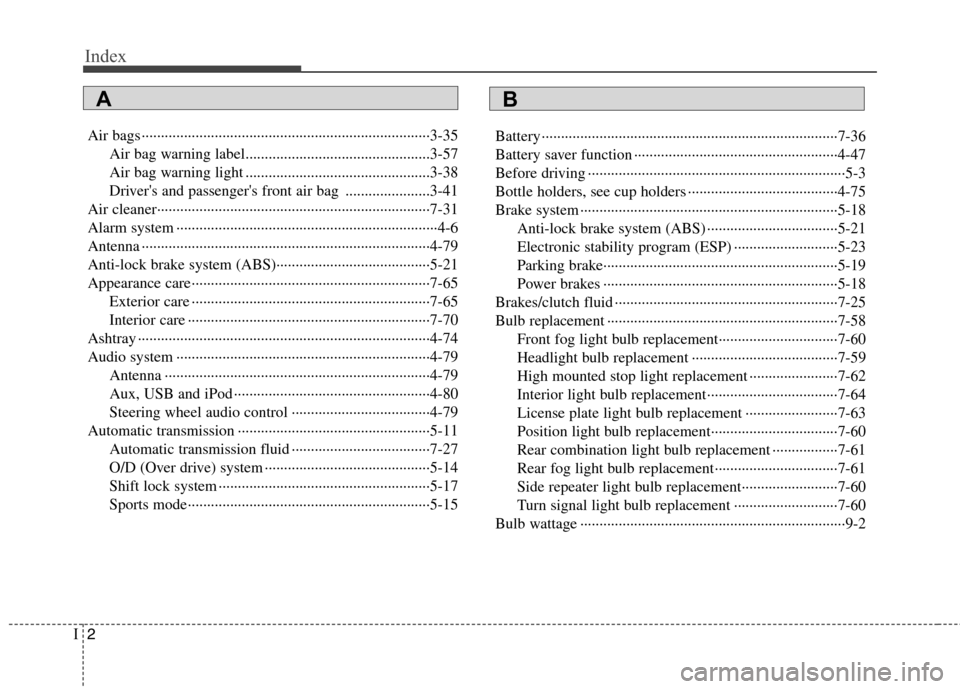
Index
2
I
Air bags ···········································································3-35
Air bag warning label................................................3-57
Air bag warning light ................................................3-38
Driver's and passenger's front air bag ......................3-41
Air cleaner·······································································7-31
Alarm system ····································································4-6
Antenna ···········································································4-79
Anti-lock brake system (ABS)········································5-21
Appearance care······························································7-65 Exterior care ······························································7-65
Interior care ·······························································7-70
Ashtray ············································································4-74
Audio system ··································································4-79 Antenna ·····································································4-79
Aux, USB and iPod ···················································4-80
Steering wheel audio control ····································4-79
Automatic transmission ··················································5-11 Automatic transmission fluid ····································7-27
O/D (Over drive) system ···········································5-14
Shift lock system ·······················································5-17
Sports mode·······························································5-15 Battery ·············································································7-36
Battery saver function ·····················································4-47
Before driving ···································································5-3
Bottle holders, see cup holders ·······································4-75
Brake system ···································································5-18
Anti-lock brake system (ABS) ··································5-21
Electronic stability program (ESP) ···························5-23
Parking brake·····························································5-19
Power brakes ·····························································5-18
Brakes/clutch fluid ··························································7-25
Bulb replacement ····························································7-58 Front fog light bulb replacement·······························7-60
Headlight bulb replacement ······································7-59
High mounted stop light replacement ·······················7-62
Interior light bulb replacement··································7-64
License plate light bulb replacement ························7-63
Position light bulb replacement·································7-60
Rear combination light bulb replacement ·················7-61
Rear fog light bulb replacement································7-61
Side repeater light bulb replacement·························7-60
Turn signal light bulb replacement ···························7-60
Bulb wattage ·····································································9-2
AB
Page 340 of 346
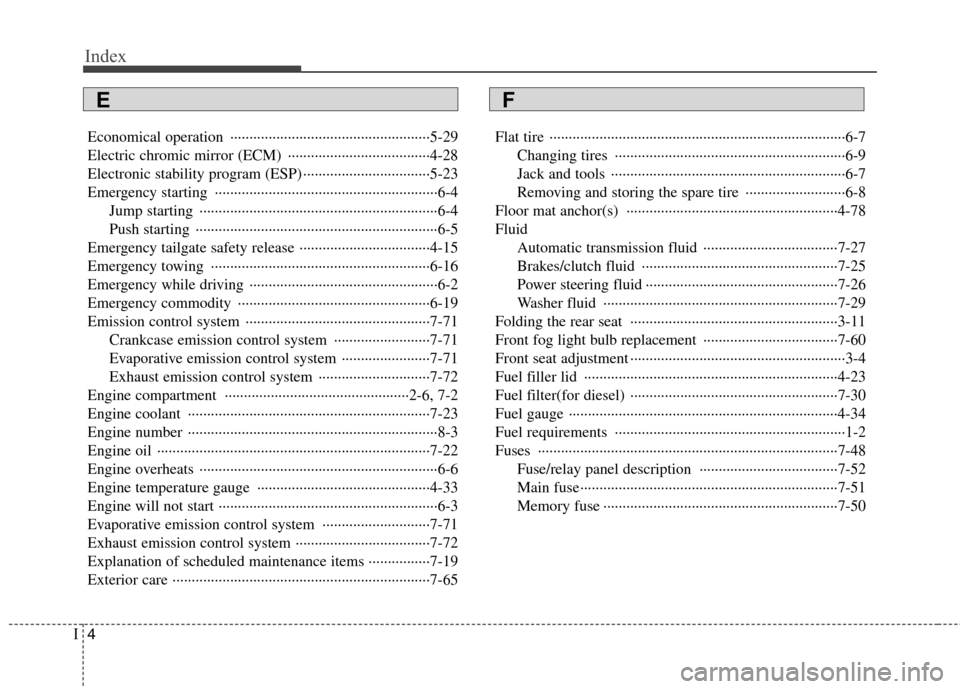
Index
4
I
Economical operation ····················································5-29
Electric chromic mirror (ECM) ·····································4-28
Electronic stability program (ESP) ·································5-23
Emergency starting ··························································6-4
Jump starting ······························································6-4
Push starting ·······························································6-5
Emergency tailgate safety release ··································4-15
Emergency towing ·························································6-16
Emergency while driving ·················································6-2
Emergency commodity ··················································6-19
Emission control system ················································7-71 Crankcase emission control system ·························7-71
Evaporative emission control system ·······················7-71
Exhaust emission control system ·····························7-72
Engine compartment ················································2-6, 7-2
Engine coolant ·······························································7-23
Engine number ·································································8-3
Engine oil ·······································································7-22
Engine overheats ······························································6-6
Engine temperature gauge ·············································4-33
Engine will not start ·························································6-3
Evaporative emission control system ····························7-71
Exhaust emission control system ···································7-72Explanation of scheduled maintenance items ················7-19
Exterior care ···································································7-65 Flat tire ·············································································6-7
Changing tires ····························································6-9
Jack and tools ·····························································6-7
Removing and storing the spare tire ··························6-8
Floor mat anchor(s) ·······················································4-78Fluid Automatic transmission fluid ···································7-27
Brakes/clutch fluid ···················································7-25
Power steering fluid ··················································7-26
Washer fluid ·····························································7-29
Folding the rear seat ······················································3-11
Front fog light bulb replacement ···································7-60
Front seat adjustment ························································3-4
Fuel filler lid ··································································4-23
Fuel filter(for diesel) ······················································7-30
Fuel gauge ······································································4-34
Fuel requirements ····························································1-2Fuses ··············································································7-48 Fuse/relay panel description ····································7-52
Main fuse···································································7-51
Memory fuse ·····························································7-50
EF